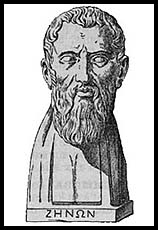Where the techniques of Maths
are explained in simple terms.
Calculus - Historical developments.
- Algebra & Number
- Calculus
- Financial Maths
- Functions & Quadratics
- Geometry
- Measurement
- Networks & Graphs
- Probability & Statistics
- Trigonometry
- Maths & beyond
- Index
Calculus can be used to study any situation in which a rate of increase or decrease is involved.
The mathematical field of Calculus first began with some of the Greek mathematicians about 400-500 BC.
| One of the most important philosophers of the time was Zeno - born in Lucania (now in Southern Italy) in 490 BC. About 450 BC, he developed 40 major paradoxes and summarised these into a book of which there is now no trace. Plato references Zeno's book which he considers was stolen and the contents published later by others!!
One of the paradoxes was about the famous runner Achilles who raced against a giant tortoise (from which the story about the tortoise and the hare was derived). |
 |
Another example of one of Zeno's paradoxes, which was fundamental to the development of Calculus, stemmed from his consideration of a simple line. Zeno posed the following views:
- can you keep dividing a line into smaller and smaller pieces forever; or
- when dividing line, do you ultimately reach a situation in which you have indivisible (or atomistic) parts left which cannot be divided further?
These ideas were soon applied to the calculation of areas and volumes. A major early problem was to investigate if the area of a square inscribed in a circle could finally equal the area of the circle if the number of sides of the figure were continually doubled.
The fundamental concepts of Calculus as we know it today were finally established by Isaac Newton (born in 1642 in Woolsthorpe, England) and Gottfried Leibnitz (born in 1646 in Leipzig, Germany). In the early 1670s, both had independently developed the concepts albeit from slightly different perspectives:
|
 Gottfried Wilhelm Leibniz 1646 - 1716. |
 Isaac Newton Isaac Newton1643 - 1727. |
From this page, you link to all the resources for differentiation.
Resources for integration are accessed from the main menu above or from this hyperlink (because I make it easy for you).
Click on the topic in calculus you want and you will be transferred to the videos and test resources for that topic:
| 1. Differentiation. |
| 2. Integration. |
| 3. Approximation methods (Trapezoidal and Simpson's rules). |
| 4. Applications of calculus to the physical world
(rates of change, growth & decay, motion). |
| 5. Differentiate.... hence find. |